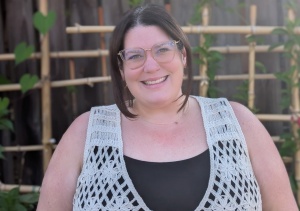A new lens on healing
The rise of ketamine-assisted psychotherapy

During a typical KAP session, the client takes the medication and enters an “alternate state of consciousness” while a therapist, like Glynn Couch, takes notes that will help them process the experience. Photo: Tom Wolf
By Matthew Biddle
Jenna Witkowski, LCSW-R, MSW ’09, was one of the first clinicians to offer ketamine-assisted psychotherapy in the Buffalo area.

Jenna Witkowski, LCSW-R, MSW ’09. Photo: Tom Wolf
A psychotherapist in private practice, Witkowski found traditional interventions only went so far for some clients with complex trauma or PTSD. She began looking for new modalities that could provide relief, as well as contribute to her own growth as someone who’s experienced trauma in her life.
At the time, around 2019, ketamine was in the news. Long used in higher doses as an anesthetic, research was emerging that showed ketamine in low doses offered promising results for a host of mental health issues. That year, esketamine — a drug derived from ketamine — won approval from the U.S. Food and Drug Administration (FDA) as a nasal spray for adults with treatment-resistant depression, and updated guidelines began incorporating ketamine and esketamine as treatment options.
“Once I started exploring these modalities, I found they were profoundly life-changing for me, personally and professionally,” Witkowski recalls. “They started to pique people’s interest and accelerate what I was offering professionally.”
Witkowski completed a 150-hour foundational training program on the broader category of psychedelic therapies and additional training on ketamine-assisted psychotherapy (KAP) and interventions for couples and groups. In 2021, she began integrating KAP into her practice, joining a growing number of clinicians who offer the intervention as part of treatment for trauma, anxiety, depression, PTSD, grief and other issues.
Prescriptions for ketamine have been steadily rising since 2017, according to market analysis firm Grand View Research, and at least 1,000 clinics nationwide now offer the drug.
“Over the last few years, there’s been a noticeable shift toward greater openness around KAP and psychedelic therapy,” Witkowski says. “Access has expanded through telehealth, clinical trials and state-level reforms, and more professionals see ketamine as a legitimate therapeutic tool, especially for conditions that haven’t resolved by other means.
“At the same time, there are still valid concerns and questions around safety, regulation and potential misuse,” she continues. “Overall, though, the field seems to be moving forward in a responsible way. Public understanding is growing, and with it, the need for thoughtful application, clinical integrity and ongoing research.”
— Jenna Witkowski, LCSW-R, MSW ’09
New perspectives

Glynn Couch, LCSW, MSW ’17. Photo: Tom Wolf
Glynn Couch, LCSW, MSW ’17, was inspired by Witkowski, a friend and colleague, to explore and eventually integrate KAP into her practice at GC Counseling PLLC.
“We often see clients stuck in their trauma,” she says. “I also provide EMDR [Eye Movement Desensitization and Reprocessing] and other modalities, but sometimes even then, clients are still stuck behind a traumatic event. Ketamine is shown to help people see beyond that and build a new perspective of their life and themselves.”
Though the drug offers some benefits on its own, integrating it with psychotherapy is critical to achieving the best results, Couch says.
“Ketamine creates neuroplasticity in the brain, so it helps the brain build new pathways to healing,” she explains. “Imagine that your brain can be rigid and firm based on what you’ve gone through, what you feel about yourself. Ketamine softens that rigidity so we can see different perspectives.”
In her North Carolina- and New York-based practice, Rachael Bruton, LCSW, MSW ’17, finds KAP can create a sense of ease, self-compassion or clarity for clients. Because of ketamine’s ability to disrupt ingrained thought patterns and beliefs, she has employed KAP when treating chronic suicidal ideation, anxiety and eating disorders.
Experts say KAP may not be appropriate when treating individuals with schizophrenia, psychosis, heart conditions or uncontrolled high blood pressure and those who are addicted to psychedelics, experiencing manic episodes, or pregnant or breastfeeding. Bruton, too, underscores that KAP is not a quick fix, and the psychotherapy component is crucial.
“The psychedelic experience can ease people back into their trauma in a way that doesn’t have to be so painful,” Bruton says. “But you must put the work in. If there’s a desperation for the medicine to fix you, I don’t find that people have effective treatment. It’s a tool that shows us something we have to work on from there on out.”
Expectations and experiences
Therapists typically partner with a doctor who can prescribe ketamine in several forms based on the client’s goals and preferences, therapeutic pacing and other factors. In Western New York, Witkowski and Couch both work with Gregory Loewen, DO, who prescribes the medication as a dissolving tablet or intramuscular injection; it can also be taken intravenously or as a nasal spray.
For Couch, any discussion of KAP begins during a traditional therapy session. After assessing a client and building rapport, Couch may recommend KAP and refer the client to Loewen, who completes a medical evaluation and writes the prescription. Loewen administers the intramuscular version for clients in his office with Couch present, while clients self-administer the tablet version in her office.
— Glynn Couch, LCSW, MSW ’17
In either case, dosing sessions begin with a conversation to prepare the client.
“The therapist’s role is to help them gain appropriate expectations of what might happen, but not to hold so tightly onto them and let what happens happen,” she says.
From there, she sets the client up on the sofa with weighted blankets, pillows, noise-canceling headphones and an eye mask — all to deprive their senses and encourage them to have an internal experience free from distractions. Then, the client takes the medication and enters what Witkowski calls an “alternate state of consciousness.”
Witkowski recalls clients who came out of the experience with profound revelations on love or the world around them. Bruton finds clients are more ready to forgive themselves or others.
Couch says: “The hope is that they experience a dissociative experience — separate from their body, as if they’re floating above themselves. We want people to feel a distance from their traditional sense of consciousness; instead of being consumed by their thoughts, they might see or imagine those thoughts.”
To better relate to clients, some therapists choose to have their own altered experience as part of their training. During Bruton’s, she entered a “dream state” that brought forward deep-rooted feelings of belonging and helped her work through a phobia she’s had since childhood.
Throughout the entire process, the therapist monitors the client, taking notes on body language or breathing changes so they can discuss the experience immediately afterward and in follow-up appointments, called integration sessions.
“That’s the best part, the psychotherapy component, where the therapist is right there to help clients process what they experienced and integrate it into their life and their mental health,” Couch says.
At a tipping point
— Rachael Bruton, LCSW, MSW ’17

Rachael Bruton, LCSW, MSW ’17.
While ketamine is legal to prescribe, the FDA has not approved it for mental health treatment, aside from the esketamine nasal spray — meaning most insurance companies won’t cover it. Providers can bill prep and integration sessions as traditional therapy appointments, but clients must typically pay out of pocket for off-label ketamine and dosing sessions, creating access and equity issues.
“As social workers, we have a responsibility to push for models of care that are ethically grounded, trauma-informed and financially accessible,” Witkowski says. “That includes integrating KAP into community mental health and insurance-based practices and offering sliding scale or group models.”
Momentum was moving toward greater access and treatment options, but that has slowed recently, according to Bruton. Last year, the FDA seemed poised to approve MDMA, another psychedelic, for PTSD treatment, but the agency rejected it and requested another phase 3 clinical trial.
In addition, while psychedelics have been used by Indigenous peoples for centuries in ceremonial rituals, healing and community bonding, they are more likely to be stigmatized as a party drug in Western cultures. High-profile cases of addiction and abuse — like the 2023 death of Friends star Matthew Perry, in part, from the effects of ketamine — only reinforce that perception.
“Public understanding is growing through media and podcasts, but because of the MDMA decision, we’ve hit the brakes,” Bruton says. “It’s heartbreaking because we don’t have good treatment in terms of medicine for severe PTSD, but we also don’t want to rush something that’s not ready.”
Witkowski remains optimistic about the future of KAP and psychedelic-assisted therapy more broadly. This year, New Mexico became the third state to decriminalize psilocybin, better known as “magic mushrooms,” to treat depression, PTSD and other disorders. PBS News reported in July that the FDA may reconsider MDMA.
Meanwhile, research continues to demonstrate the efficacy of ketamine and other psychedelics in mental health treatment. A bipartisan bill introduced in the House last spring would increase access to psychedelics for veterans and fund new clinical trials. Locally, Roswell Park Comprehensive Cancer Center created the Psychedelic Science Initiative to study psychedelics in cancer treatment.
“Psychedelic-assisted therapy is at a tipping point,” Witkowski asserts. “With promising research, growing public interest and regulatory shifts, access will likely continue expanding, especially as MDMA and psilocybin approach FDA consideration. Ketamine, being already legal, will likely remain the most accessible psychedelic tool in the near term, and I expect its use in mental health settings to keep growing.”